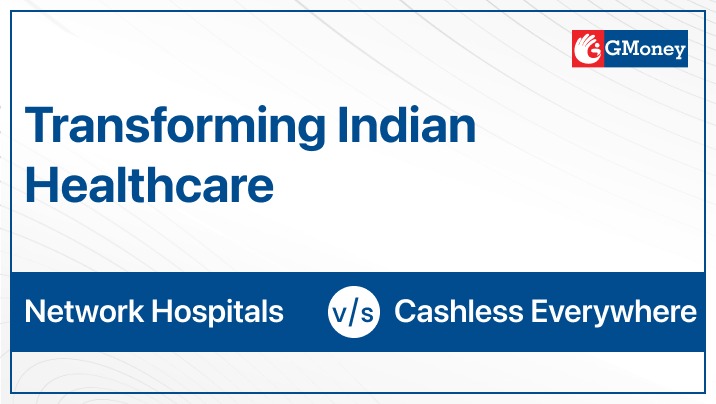Home » Comparing Network Hospitals and Cashless Everywhere: A Revolution in Indian Healthcare

Network Hospitals vs. Cashless Everywhere: A Revolution in Indian Healthcare The launch of the “Cashless Everywhere” project is causing a paradigm change in the Indian healthcare sector, with the goal of revolutionising how health insurance is used across India.
This developing effort aims to expand the cashless treatment advantages outside network hospitals, making healthcare more accessible and inclusive. Let’s look at the details of this initiative, how it compares to the existing system, and what it means for the future of healthcare in India.
At its heart, “Cashless Everywhere” is a disruptive concept that aims to expand the benefits of cashless medical treatment to any hospital, eliminating the previous restriction to network hospitals. This program allows policyholders to get medical care without the requirement for immediate payment or the bother of filing reimbursement claims.
It provides unparalleled flexibility and accessibility to healthcare services by bridging the gap between insurance companies and hospitals that were previously not in their network. This effort aims to make the insurance environment in India more accessible, allowing people to receive great healthcare whenever and wherever they need it, without the financial burden of upfront charges.
This is a considerable divergence from the traditional cashless insurance structure, establishing a new norm for health insurance utility and patient care in the country.

The introduction of cashless treatment in India paved the way for a revolutionary journey in the healthcare and insurance industries. Initially, this facility was only offered at hospitals inside an insurer’s network, resulting in a symbiotic arrangement that met the insured’s medical requirements without incurring immediate out-of-pocket costs.
However, this approach has inherent limits in terms of accessibility and convenience, particularly for people living in less urbanised regions or those who require specialised treatment that is not accessible inside the network. Over time, the desire for more adaptable and inclusive health insurance options emphasised the need for a more comprehensive strategy.
This resulted in the development and ultimate execution of the “Cashless Everywhere” campaign, a big move towards broadening the scope of cashless medical service in India by breaking free from the constraints of network-restricted care. This evolution represents a gradual trend towards a more democratic and accessible healthcare system that addresses the different demands of India’s population.
The General Insurance Council has been instrumental in the creation and implementation of the “Cashless Everywhere” project, working closely with regulatory authorities such as the Insurance Regulatory and Development Authority of India (IRDAI). These groups have worked tirelessly to provide the regulatory framework, standards, and guidelines necessary for integrating this new model with existing healthcare and insurance systems.
Their contributions have been critical in negotiating the intricacies of extending cashless treatment choices, ensuring that both insurance companies and healthcare providers are on board with the initiative’s goals. These regulatory organizations have played an important role in tackling the operational and regulatory problems connected with executing such a broad healthcare reform by encouraging communication and collaboration among many parties. Their continued commitment to managing and developing the effort promises to ensure its long-term viability and efficacy.
Under the old arrangement, cashless healthcare was limited to a specific network of facilities. This technique, while innovative at the time, frequently caused logistical and budgetary issues to patients. If a chosen or specialized hospital was not part of an insurer’s network, consumers were forced to choose a less acceptable network hospital or pay in advance at their preferred institution and then navigate the time-consuming reimbursement procedure.
This design limited patient options and often caused delays in access to important healthcare treatments. “Cashless Everywhere” intends to break down these obstacles, creating a healthcare system in which patients’ preferences and medical needs drive hospital selection rather than insurance network limits. This fundamental transformation not only increases patient autonomy, but also demonstrates a commitment to universal healthcare access, regardless of geography or financial constraints.
The “Cashless Everywhere” program aims to democratize healthcare by guaranteeing that financial restraints do not prevent patients from receiving vital medical treatments. It intends to empower policyholders by eliminating the conventional constraints associated with cashless insurance, particularly the network hospital constraint, and giving them the choice to pick their healthcare provider based on need rather than financial capabilities or network limits.
This transition is expected to dramatically reduce the burden of medical expenditures on individuals, particularly during crises, by allowing for instant, cashless access to healthcare services across a wide range of facilities. Furthermore, by widening the eligibility for cashless treatment, the effort is projected to foster a more competitive environment among hospitals, perhaps leading to improvements in the quality of healthcare services offered to the public.
“Key features and how it differs from traditional cashless insurance” highlights the innovative components of the “Cashless Everywhere” project. This innovative strategy provides an unprecedented level of inclusion, allowing people to use cashless healthcare services at any hospital, not only those in a specialized network. This is in sharp contrast to the existing paradigm, which limits patients’ options to network hospitals, reducing their freedom of choice.
Furthermore, the effort considerably improves the claims procedure. It reduces the complications and delays that are frequently associated with the reimbursement system, making the transition from treatment to recovery easier and faster for policyholders. “Cashless Everywhere” transforms the health insurance environment by providing an improved and more user-friendly experience, putting patient comfort and access first and foremost.

The launch of the “Cashless Everywhere” campaign marks a significant shift in India’s health insurance environment. Given the increased flexibility and accessibility, insurers should expect a boom in policy subscriptions as customers see the benefit of health insurance. This shift forces insurance firms to rethink and maybe revamp their product portfolios in order to cater to a more discriminating consumer base seeking comprehensive and easy coverage alternatives.
The transition might create a highly competitive market, encouraging innovation and improving service quality across the board. Insurers may also find themselves investing more in technology and forming alliances with a larger range of healthcare providers to support cashless transactions. This adaptability not only meets changing customer expectations, but also paves the way for a more dynamic and resilient health insurance business.
Implementing the “Cashless Everywhere” project has various challenges that must be carefully navigated. Among them, the formation of a consistent set of medical costs across various hospitals poses a substantial challenge, since it requires a level of uniformity that is difficult to attain given the diverse cost structures of healthcare institutions. Additionally, developing a sophisticated and resilient technology infrastructure to support smooth cashless transactions is a challenging challenge.
This infrastructure must be able to safely and efficiently manage a large volume of claims and patient data. Furthermore, achieving widespread acceptance and collaboration from hospitals outside typical insurance networks necessitates strategic negotiation and alignment of interests, which may be difficult and time-consuming. To realize the full potential of the “Cashless Everywhere” project, all parties engaged in the healthcare and insurance sectors must work together and find new solutions to these issues.
Looking ahead, “Cashless Everywhere” is expected to drive major breakthroughs in the technology infrastructure that underpins health insurance transactions. Artificial intelligence (AI) integration for more effective claim processing and the usage of blockchain technology for safe and transparent transactions are among the innovations on the horizon. These technology advancements will simplify processes, reduce fraud, and increase the overall customer experience.
Furthermore, increased understanding and appreciation of the initiative’s benefits are projected to inspire a wider range of people to use cashless healthcare services. This trend will most certainly result in a rise in demand for plans with such flexibility, driving insurance companies to innovate and broaden their products. As the project gets traction, it has the potential to spark a larger shift toward more patient-centered healthcare models, resulting in systemic improvements in care delivery and health outcomes across India.
We recently came across one remarkable example of the usefulness of “Cashless Everywhere” where in a small company owner from a semi-urban region (near Pune) who experienced a medical emergency. Under the old system, receiving care would have required either a long trip to an in-network hospital in Pune or significant out-of-pocket payments at a nearby institution. Thanks to “Cashless Everywhere,” the individual was able to obtain quick care at a nearby hospital, reducing travel stress and financial concerns during this emergency.
This story vividly demonstrates how the program is going to make healthcare more accessible and available to all, especially for people living in less urbanized areas. It emphasises the direct advantages to patients while also underlining the larger societal consequences of ensuring that everyone has access to timely and high-quality medical treatment without financial burden.

About GMoney Seven Sigma:
At GMoney Seven Sigma, we’re revolutionizing Revenue Cycle Management (RCM) services in India. Our mission is to simplify and enhance cashless transactions, ensuring that hospitals can focus on what they do best – providing excellent patient care. Our dedication to seamless service and customer satisfaction drives us to deliver top-notch solutions tailored to the unique needs of the healthcare industry.
RCM Services:
Transform Your Hospital’s Financial Health with GMoney’s RCM Services:
Our comprehensive RCM solution is designed to address the challenges faced by hospitals today. From streamlining billing and coding to efficient claims processing and payment collection, we’ve got you covered. Our team of experts collaborates with you to eliminate bottlenecks, boost efficiency, and maximize reimbursements. We manage Insurance / TPAs, Ayushman Bharat, CGHS, SGHS, ECHS, Most Govt and state run health schemes.
Why Choose GMoney’s RCM Service?
Specialized in Delay and Denied Claims Processing:
We understand the frustration and financial strain caused by delayed and denied claims. GMoney specializes in tackling these issues ensuring that your hospital recovers stuck claims .
Empower Your Hospital with GMoney Seven Sigma:
Embrace a more efficient and profitable future with GMoney’s RCM services. Our dedicated team is here to empower your hospital to navigate the complexities of healthcare finance successfully. Don’t let financial challenges hold your hospital back. Contact our relationship managers today for a discussion on how GMoney Seven Sigma can assist you.
Follow us
Reach us
Mumbai HO
GMoney Pvt. Ltd.
315, 215 Atrium,
Next to Courtyard by Marriott,,
A.K. Road, Andheri East,
Mumbai - 400093
Ph : +91 86570 00105, +91 72089 60444
Quick Links
Bengaluru
GMoney Technologies Pvt. Ltd.
Oyo Work Spaces, Umiya Emporium,
Opposite Forum Mall, Hosur Rd,
Koramangala, Bengaluru,
Karnataka 560029
Ph : +91 89717 34815
Delhi
GMoney Technologies Pvt. Ltd.
Berry Co Works, 1E/3,
Jhandewalan extension,
Next to jhandewalan metro station
gate no. 2 Barakhambha Road,
New Delhi, Delhi 110001
Ph : +91 97116 26832
Pune
GMoney Technologies Pvt. Ltd.
91 Spring Board, Sky Loft,
Creaticity Mall, Off, Airport Rd,
opposite Golf Course, Shastrinagar,
Yerawada, Pune,
Maharashtra 411006
Ph : +91 84250 28758
Chandigarh
GMoney Technologies Pvt. Ltd.
SCO no. 292,
First Floor, Sector 35D,
Chandigarh
Ph : +91 84279 82012
Jaipur
GMoney Pvt. Ltd.
CODESKK Civil Tower,121 122,
Pandit TN Mishra Marg,
Santhosh Nagar, Nirman Nagar,
Jaipur – 302019
Ahmedabad
GMoney Pvt. Ltd.
22nd Floor, B Block,
Westgate By True Value,
Nr. YMCA Club, SG Highway,
Ahmedabad – 380051
Hyderabad
GMoney Pvt. Ltd.
Dwaraka Pride,
Plot no. 4/1, Survey No. 64,
Huda Techno Enclave, Madhapur,
Hyderabad (Telangana) – 500081
Chennai
GMoney Pvt. Ltd.
DBS Business Center, 31A,
Cathedral Garden Rd, Badrikari, Tirumurthy Nagar, Nungambakkam, Chennai, Tamil
Nadu – 600 034
Mumbai HO
GMoney Pvt. Ltd.
315, 215 Atrium,
Next to Courtyard by Marriott,,
A.K. Road, Andheri East,
Mumbai - 400093
Ph : +91 86570 00105, +91 72089 60444
Bengaluru
GMoney Pvt. Ltd.
Oyo Work Spaces,
Umiya Emporium,
Opp. Forum Mall, Hosur Rd,
Koramangala, Bengaluru,
Karnataka - 560029
Ph : +91 72089 60444
Pune
GMoney Pvt. Ltd.
91 Spring Board, Sky Loft,
Creaticity Mall, Airport Rd,
Opp. Golf Course, Shastrinagar,
Yerawada, Pune,
Maharashtra - 411006
Ph : +91 72089 60444
Delhi
GMoney Pvt. Ltd.
Berry Co Works, 1E/3,
Jhandewalan extension,
Gate no. 2 Barakhambha Road,
New Delhi, Delhi - 110001
Ph :
+91 72089 60444
Chandigarh
GMoney Pvt. Ltd.
SCO No. 292,
First Floor, Sector 35D,
Chandigarh - 160022
Ph : +91 72089 60444
Ahmedabad
GMoney Pvt. Ltd.
22nd Floor, B Block,
Westgate By True Value,
Nr. YMCA Club, SG Highway,
Ahmedabad - 380051
Hyderabad
GMoney Pvt. Ltd.
Dwaraka Pride,
Plot no. 4/1, Survey No. 64,
Huda Techno Enclave, Madhapur,
Hyderabad (Telangana) - 500081
Jaipur
GMoney Pvt. Ltd.
CODESKK Civil Tower,121 122,
Pandit TN Mishra Marg,
Santhosh Nagar, Nirman Nagar,
Jaipur - 302019
Chennai
GMoney Pvt. Ltd.
DBS Business Center, 31A,
Cathedral Garden Rd, Badrikari,
Tirumurthy Nagar,Nungambakkam, Chennai,
Tamil
Nadu - 600 034
Pune | Mumbai | New Delhi | Kolkata | Chennai | Navi Mumbai| Bengaluru | Ahmedabad | Nagpur | Hyderabad | Jaipur | Lucknow | Bhopal | Bhubaneswar | Nashik | Indore | Ghaziabad | Kanpur | Amritsar | Vasai | Noida | Gurugram | Chandigarh | Ranchi | Cuttack | Thane | Kalyan | Jalandhar | Kolhapur | Visakhapatnam | Chakan| Greater Noida | Wagholi | Raipur | Panvel | Belgaum | Mohali | Bhiwandi | Talegaon | Coimbatore | Palghar | Mumbra | Sangli | Surat | Durgapur | Ludhiana | Kochi | Agra | Ahmednagar | Ajmer | Akola | Aurangabad | Baroda | Beed | Rewari | Patiala | Vellore | Ranjangaon | Nanded | Nellore | Panipat | Panjim | Madurai | Mysore | Mangalore | Korba | Mathura | Kalaburagi | Jalgaon | Kharar | Guwahati | Kollam | Jamshedpur | Gwalior | Saswad | Solapur | Varanasi | Salem | Sambalpur | Jodhpur | Hubli | Panchkula | Faridabad | Amravati | Ayodhya | Badlapur | Dehradun | Parbhani | Ujjain | Udaipur | Tiruchirappalli | Srinagar | Shimla | Secunderabad | Ratnagiri | Pandharpur | Ananthapuram | Buldhana | Hadapsar | Baramati | Chittoor | Darjeeling | Dhule | Fatehpur | Gandhinagar | Haridwar | Gorakhpur | Jhansi | Kanchipuram | Kartarpur | Kurukshetra | Pondicherry | Prayagraj | Bharuch | Bhusawal | Bathinda | Pathankot | Nandurbar | Niphad | Kolar | Ambala | Kota | Pendurthi | Jabalpur | Palwal | Bhilai | Bhiwani | Bilaspur | Patna | Rohtak | Phagwara | Malegaon | Vijayawada | Bikaner | Chiplun | Darbhanga | Roorkee | Bhor | Rajahmundry | Margao | Alwar | Dhanbad | Bulandshahr | Aluva | Mulshi | Davanagere | Kapurthala | Anantapur | Loni | Latur | Gondia | Chhindwara | Chandrapur | Dharmapuri-TN | Faridkot | Dharwad | Daund | Chaksu | Bareilly | Kakinada | Haldwani | Doddaballapur | Dindori-MH | Bagru | Kudus | Kozhikode | Gurdaspur | Bokaro | Berhampur | Batala | Barrackpore | Ramgarh | Meerut | Bassi | Dera Bassi | Howrah | Karjat Raigarh | Thiruvananthapuram | Bheemunipatnam | Ambegoan | Allahabad | Aligarh | Alappuzha | Tirupathi | Thoppumpady | Srikakulam | Siliguri | Rourkela | Mirzapur | Gadag | Bellary | Tumkur | Sonipat | Hoshangabad | Junnar | Jalna | Hisar | Karnal | Kottayam | Muzzafarnagar | Ramnagara | Thrissur | Bahadurgarh | Balasore | Baraut | Dhar | Ernakulam | Gadhinglaj | Chikodi | Vaniyambadi | Kamothe |